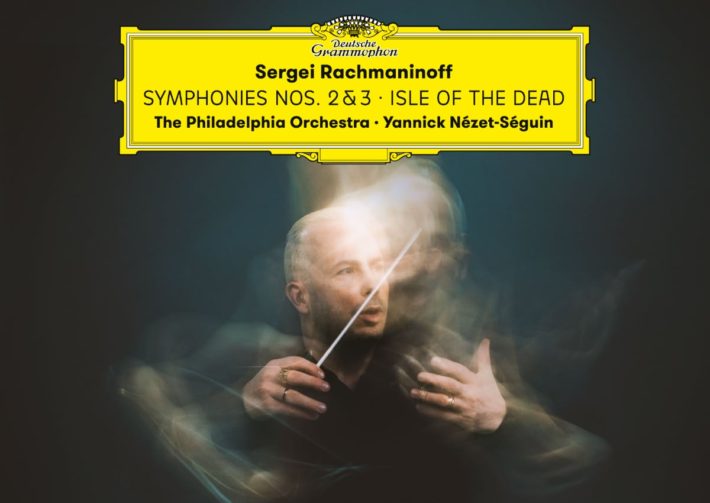Next to Daniil Trifonov’s cycle of the piano concertos with these forces, this completes Philadelphia’s new Rachmaninoff symphony cycle, which began with a February 2021 release of ‘Symphonic Dances’ and ‘Symphony No. 1.’ I wrote enthusiastically about that release and have anxiously awaited this follow up. Growing up in Philadelphia, I was weaned on Ormandy’s Rachmaninoff, but sonically those recordings show their age, and many of us have hoped for a new Philadelphia cycle in the digital era. In the 1990s Decca tried with a series of recordings led by the orchestra’s principal guest conductor Charles Dutoit, but they were sonically and interpretively disappointing. So, the success of the 2021 recording proved especially exciting, and the question now is whether, with this new album, we finally have a set of Rachmaninoff symphonies excellently performed that fully capture the fabulous Philadelphians in state-of-the-art sound?
The exhilarating performance of the second symphony answers with a resounding yes. DG’s engineers capture the warmth and richness of Verizon Hall while ensuring great transparency. More crucially, Nezet-Sequin leads a fervently romantic reading: the introduction has a potent brooding atmosphere, followed by an Allegro moderato (Tr. 2, DG divides the first movement into three tracks) that takes its time. Nézet-Séguin uses generous amounts of rubato, revealing lots of inner detail even as he revels in the incredible richness of those Philadelphia strings. Surprisingly, he chooses not to take the exposition repeat (a choice sanctioned by the composer) – but with playing this beautiful, who would not want to hear it again? The build-up to the main climax (7’50”) is masterfully done, eclipsed only by Litton’s even momentous approach (heard on both his RPO/Warner Classics and Bergen PO/BIS recordings).
The second movement has tremendous energy and panache. A slight easing of tempo for the trio heightens the change in mood, the music more forlorn and ominous. But it is the third movement that reaches a higher, superlative level. Ricardo Morales’ opening solo (I assume it is the orchestra’s principal clarinet, DG regretfully does not list any personnel) is heartbreakingly beautiful, filled with longing and regret. Nézet-Séguin’s phrasing is flexible without feeling mannered or overdone, and the players seize on this flexibility, playing with a burnished lyricism that completely captivates. As they make melodies soar and blossom, it is impossible to imagine the music being performed in any other way.
Related Posts
- Review: Rachmaninoff – Symphony No. 1, Symphonic Dances – Philadelphia Orchestra, Nézet-Séguin
- Review: “Destination Rachmaninov – Departure” – Piano Concertos No. 2 & 4 – Daniil Trifonov, The Philadelphia Orchestra, Yannick Nézet-Séguin
- Review: Florence Price – Symphonies 1 & 3 – Nézet-Séguin
The fourth movement is more moderately paced than I initially wanted, but on repeated listening I realized the malleable phrasing and voluptuous weight of the sound prove the rightness of this tempo. In the coda, Nézet-Séguin steadily ratchets up the tension, giving the final pages a sense of cathartic sense of joy.
The third symphony also receives a thrilling reading. This music is less ‘heart on sleeve’ than the second; indeed, its leaner orchestration and sparser style confused the first audiences and critics when Stokowski and the Philadelphians premiered it in 1936. The composer recorded the symphony (and ‘The Isle of the Dead’) with the orchestra three years later, and I was curious if Nézet-Séguin might incorporate elements of Rachmaninioff’s recording into his interpretation. The composer is faster in every movement, but his liberal use of rubato, as well as the richly sonorous string sound he obtains from the orchestra, indicate Nézet-Séguin’s way with this music would very much please the composer. There are still plenty of moments of soaring melody, and the Philadelphians make the most of them. Sample the violin line beginning at Tr. 8, 1’14” – this is always played beautifully, but here it has a shape and intensity that reveal a deeper emotion, an ecstasy reminiscent of the cowbell passage in the first movement of Mahler’s sixth symphony. This kind of emotional exploration is what I remember about the Ormandy recordings, and that one finds in Rachmaninoff’s own recording.
The second movement’s shift from Adagio to Scherzo is beautifully handled, brass sonorous and rounded, never blaring. The final offers plenty of virtuosity, but more impressive still is how Nézet-Séguin reveals the music’s myriad of emotions. Listen to the joyous frivolity evaporate as the strings dig into their angst-ridden lines at 1’30” (Tr. 9). The Coda, too, lets us know that the victory is hard-won and not at all assured.
There is little to add about the final track, ‘The Isle of the Dead,’ except to note that the same qualities of sound, flexible phrasing, and deep emotional connection are experienced here, making it one of the most atmospheric and successful readings I know.
Having followed and written about Nézet-Séguin’s work for several years, I am confident in writing that this is the best work he has done – this is the set for which I have long waited, and I very much hope this team will go on to record more Rachmaninoff – urgently recommended.

Rachmaninoff – Symphonies No. 2 & 3, Isle of the Dead
The Philadelphia Orchestra
Deutsche Grammophon, CD 4864775
Recommended Comparisons
Previn | Jansons | Ormandy | Wilson
Read more classical music reviews or visit The Classic Review Amazon store
Follow Us and Comment:
Get our periodic classical music newsletter with our recent reviews, news and beginners guides.
We respect your privacy.








